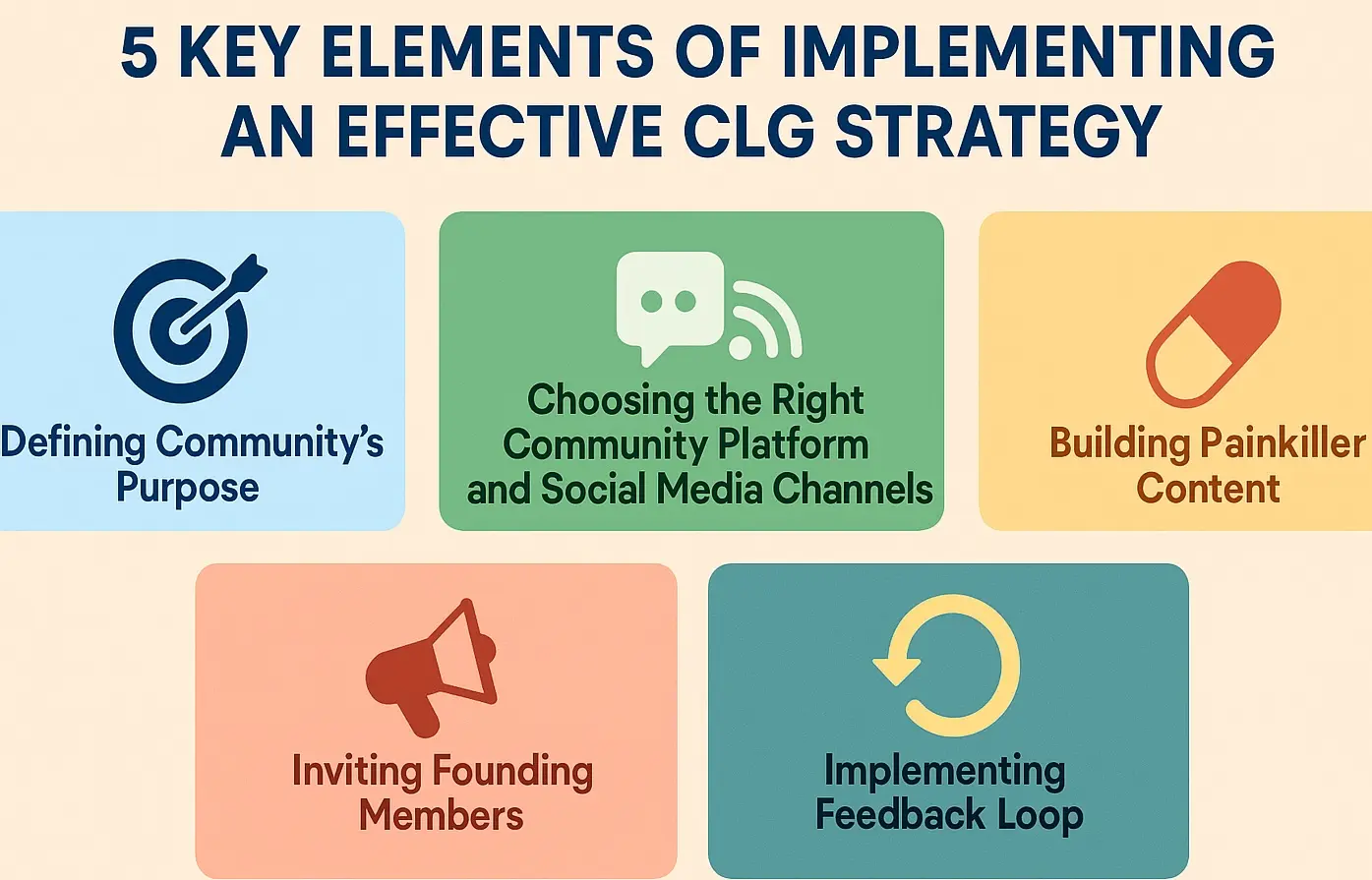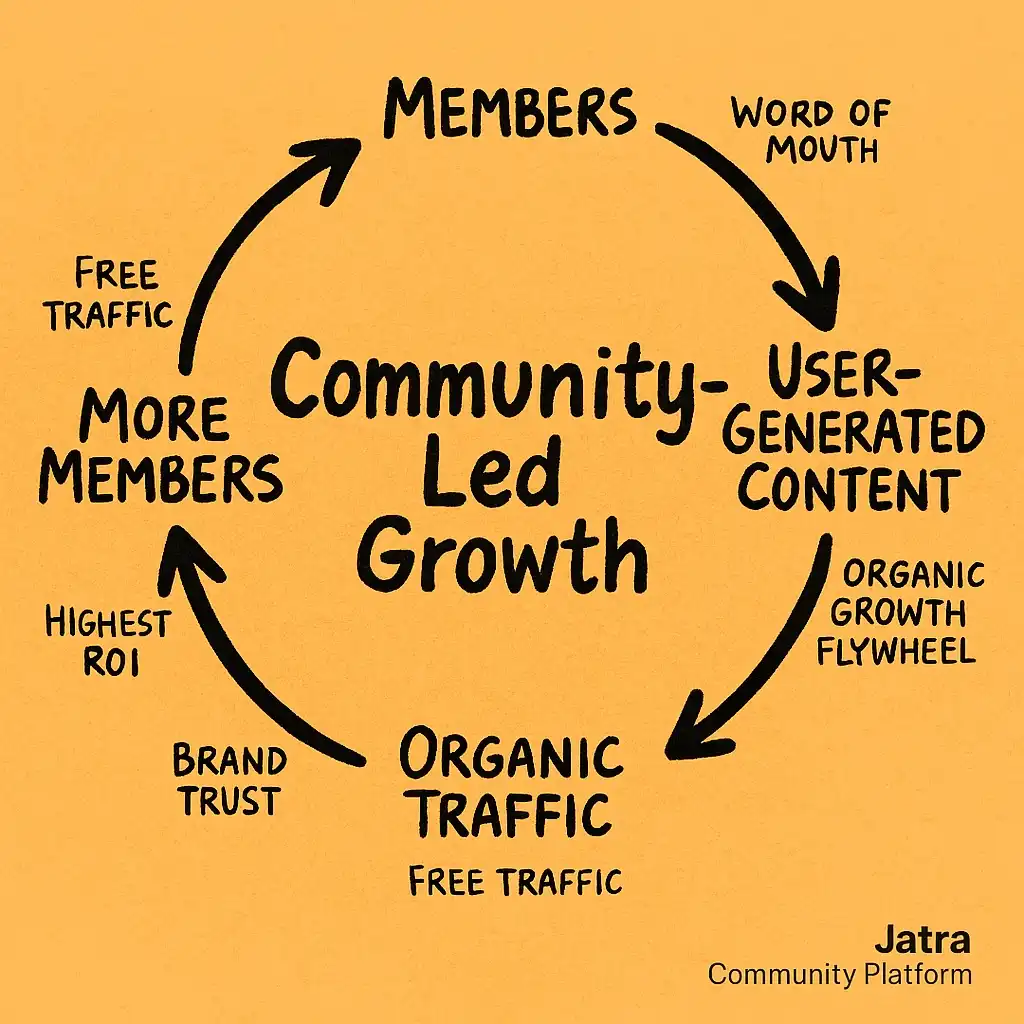In this article, we’ll talk about community-led growth and discuss an easy way to implement it for your business.
Prior to founding the Jatra Community Platform, I led growth marketing at a funded, high-growth startup. You know our best-performing growth hack? You guessed it: it was building our own, branded customer community.
I believe any online business - yep, B2B and D2C included - can and should build their own online community.
Here's the key: it should be 100% under your control, meaning it can't be a closed community or hosted solely on social media platforms like Facebook, WhatsApp, LinkedIn, or Reddit.
Let me explain. But let’s start with absolute basics.
What is Community-Led Growth, Anyway?
Community-led growth (CLG) is a GTM strategy where your existing users organically drive marketing, sales, and retention.
Imagine your community as an all-in-one channel that effortlessly generates more business, product insights, customer feedback, and enthusiastic advocates; almost on autopilot.
While the idea behind CLG isn't brand new, it’s only recently gained attention as a core growth strategy.
The Key Benefits of CLG
Over the last few years, we have observed the following key benefits for businesses:
1. Low Costs, High Returns
You don’t need huge budgets, resources or team to implement community-led growth for your business. As we’ll see in our strategic guide below, you can start with existing customers and investing in content.
The good part is that CLG is self-sustaining and is driven by organic growth strategies, SEO and referrals.
#2. Authentic Word-of-Mouth
Your community members become vocal champions of your brand. Satisfied users naturally share their positive experiences within the community and on the social media.
This beats the traditional ads and reduces your customer acquisition costs.
#3. Peer-to-Peer Support
Your community acts as a customer support channel on autopilot. Engaged customers often help other customers with their problems.
It’s faster, very reliable and reduces the burden on your customer support teams. An additional benefit is that the users are often active 24/7, and quick help is often minutes away.
#4. Authentic Customer Feedback
You no longer have to spend money on surveys, emails, phone calls and meetings with customers. Your community is a goldmine of real-time feedback and insights.
Discussions, posts, polls, replies - all are sources of the real feedback where users discuss their pain-points, goals, motivations et al.
#5. Strong Brand Trust and Authority
By facilitating genuine conversations and user-generated content, community-led approach brings credibility, authenticity and trust to the brand.
If a user complains - the business can respond fast; and make the user heard.
These discussions can also help establish your brand as a thought-leader in the industry.
#6. Organic Growth Flywheel
This perhaps is the most powerful aspect of community being a growth flywheel. Your engaged users create content. This content has the potential to bring more users through organic searches.
Engaged users happily refer other users to your brand.
The beauty of user-generated content is that it can bring traffic for years! Oh, did we tell you: It was user-generated; you didn’t have to spend anything to get that traffic.
Fortunately, implementing community-led growth today is simpler than ever.
Our CLG implementation strategy draws upon years of experience in building business communities from scratch - and growing them to tens of thousands of engaged users. Take a look below.
Implement Community-Led Growth Strategy (Step-by-Step)
There are 5 key elements of implementing an effective CLG strategy -
Defining Community’s Purpose
Choosing the Right Community Platform and Social Media Channels
Building Painkiller Content
Inviting Founding Members
Implementing Feedback Loop
Pay close attention to the order. It’s important and we’ll soon see why. Let’s take a deeper look at each of the above elements.

1. Defining Community’s Purpose and Value
Start by asking a simple question:
What value should my community provide to our users?
Think about the common goals or interests that would bring your users together. It could be a common pain-point in your niche that affects majority of your users. Sometimes, it can be a motivation or a fear that might bring them together.
For example, a D2C skincare brand might have users who deeply care about healthy, glowing skin. These users may have several questions about products, their usage, skin diseases, product ingredients etc.
This company can build a community in the skincare niche that helps users with their skincare problems, offers direct interaction with experts and peers.
Take another example - a B2B SaaS in email marketing domain. The users are most likely the marketing professionals who want to send effective campaigns, maximise RoI, write better campaigns, need technical help with DMARC, DKIM, SPF records and other marketing help.
In this case, the company can build a community hyper-focused on helping marketers with email marketing.
It’s essential to define the community’s purpose and have a clear idea of what value it will provide to users.
Next, it’s important to choose a platform to host your community.
2. Choosing the Right Community Platform and Social Media Channels
It’s important to understand that your social media audience is not your community. Social media is for broadcast and expanding your reach.
It’s important to choose a dedicated community platform so that you have a full control over the community. It’s also important to choose your social media channels to amplify your reach.
Rule #1: Choose Open Platform Over Closed One
An open platform is the one that exposes its content to the users without signing-up; while a closed platform makes content accessible only to its logged-in members.
An open platform gives you organic community growth through SEO and it’s our top recommendation. However, there are legit use-cases where a closed platform is an obvious choice: a paid-course community or a community of users limited to employees of a company or students from a school.
Reference: Open Vs. Closed Communities
Rule #2: Your Community Should Not Be on Social Media
Social media is designed to limit your reach so that you pay them continuously. Time and again, we’ve found that social media communities work the best for casual communities and interactions. These communities are extremely difficult to grow.
Also, the members that sign-up on your community cannot be reached through email or SMS. There is no way to nurture them; because their data is always hidden from you.
Instead, choose a platform dedicated to community building. There are several choices:
Jatra (this platform; made for organic growth and engagement)
Circle (good for creator communities)
Discourse (good choice for b2b communities)
Flarum (open source, good for developer communities)
Mighty Networks (bit complicated, but a good community platform)
…and there are many.
The choice of community platform depends on several factors like type of community, user requirements and most importantly - your budget.
3. Building Painkiller Content
We live in a world where our attention span is lesser than that of a goldfish. It’s therefore important to capture your audience’s attention as quickly as possible.
The best way to do it? Build painkiller content!
Painkiller content for community solves an immediate pain that user is experiencing. It could be an answer to a question, an educational article, a webinar, a chat etc.
The painkiller content builds an instant connect with the user and absorbs them into your ecosystem.
It’s essential to build the painkiller content base before you invite your first members.
4. Inviting Founding Members
It’s okay to launch your community small.
It gives you enough space to understand what your users actually want from the community, define its culture and build better content as you prepare for growth.
Invite the most enthusiastic customers or users of your product. Give them an early access and find out how they interact with the content.
Take their feedback to build better content and motivate them to interact on the community. It’s important to make them feel special.
When users have peer-to-peer interactions, ask questions, get answers and help each other - it creates a lasting network effect.
Your early members will set the tone and culture of your community.
The content created by your members is “GOLD” from SEO-perspective. It serves the long-tail keywords that are harder to identify through SEO tools and techniques.
You should start receiving organic traffic to your community. It’s like free inflow of users who might become your customers.
Recommended Reading: Get first 100 community members
5. Implement Feedback Loop
As more members join your community, it’s essential to make them a part of your company’s progress. There are several ways to do this:
Motivate them to share feedback about your product / business
Make sure that they are informed about the actions you have taken
Ask them for advice and seek their opinions
Let them be the early users when you release a new feature or an update
Keep track of the most active users, their posts, questions and discover the common pain-points that your community talks about.
Use this insight to shape your product and roadmap. Let your community play an important role in your overall business growth.
Community-Led Growth Examples in Various Sectors
One of the best things about community-led growth is that it can be applied to almost any type of business. Let’s look at some of examples of companies that have implemented CLG.
Business-to-Business (B2B CLG)
In the B2B world, community-led growth often takes the form of user-groups, professional networks or developer communities.
Businesses use communities to help their customers (who are often other businesses or professionals) get more value from the product or to advance their industry knowledge.
For example Asana, a project management SaaS, has a community where users share workflow tips and ask questions. This deepens their relationship with the product and the Asana team.
SAP, the enterprise software giant has a community acting as knowledge hub for their users. It’s a prime example of how community can drive business growth, help developers troubleshoot and exchange expertise.
Direct to Consumer (D2C CLG)
The D2C business presents more challenge because the user-group is diverse. We have observed that D2C brands benefit from building a lifestyle and sense of belonging around the brand.
Peloton for example, sells exercise bikes and fitness content. But what makes them really successful is their community aspect: people riding ‘together’ from home, competing on leaderboards and sharing their progress with each other.
Lululemon, an athletic apparel brand has ambassador program that unites local Yoga instructors and fitness leaders to create micro-communities of enthusiasts.
When customers feel connected with a cause that the brand stands for, they tend to become repeat customers and stay loyal to the brand.
Conclusion: The Future is Community-Led
Community-led growth is the most sustainable approach to growing a business; and making it AI-proof. It puts your customers front and center.
The formula is simple: If you invest in your community, your community will invest in your growth.
You don’t need massive budgets or team to begin. A handful of passionate users from your existing customer-base can kickstart your community and take it to new heights.
We live in a world where consumers want deep connection and authenticity; and community-led is the easiest way to stand-out.
Whether you are a CMO or a Founder - community-led growth can be a game-changer for your business and take it to the next level.
